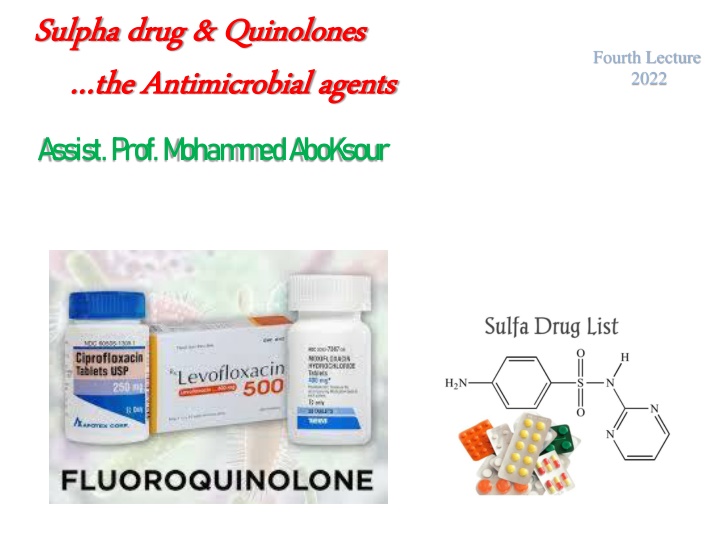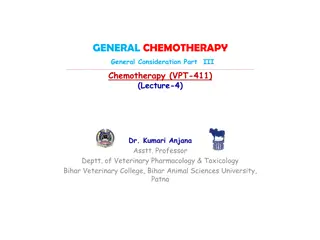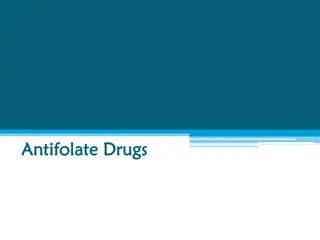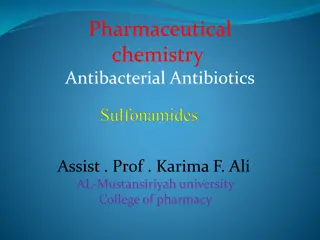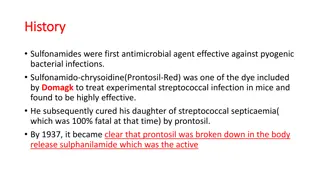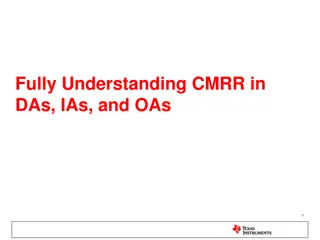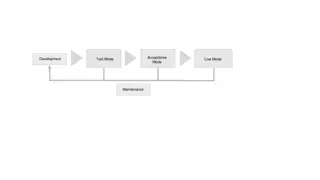Sulfonamides and Their Mode of Action
Sulfonamides, also known as sulfa drugs, are synthetic antimicrobial agents that interfere with bacterial metabolism by targeting the dihydropteroate synthetase enzyme. This disruption inhibits folate synthesis, essential for nucleic acid production in bacteria. Common examples include co-trimoxazole for treating bacterial infections, with potential side effects and variations in toxicity. Succinyl sulfathiazol and Sulfadoxine are newer generations of sulfa drugs with distinct properties and dosing regimens.
Download Presentation

Please find below an Image/Link to download the presentation.
The content on the website is provided AS IS for your information and personal use only. It may not be sold, licensed, or shared on other websites without obtaining consent from the author.If you encounter any issues during the download, it is possible that the publisher has removed the file from their server.
You are allowed to download the files provided on this website for personal or commercial use, subject to the condition that they are used lawfully. All files are the property of their respective owners.
The content on the website is provided AS IS for your information and personal use only. It may not be sold, licensed, or shared on other websites without obtaining consent from the author.
E N D
Presentation Transcript
Sulpha Sulphadrug & Quinolones drug & Quinolones the the Antimicrobial agents Antimicrobial agents A ssist. P rof. M oham m ed A boK sour Fourth Lecture 2022
Sulfonamide, Sulphanoamide,Sulfa or Sulpha drugs Sulfonamides are synthetic antimicrobial agents that contain the active antibacterial sulfonamide group which is the first synthetic antibacterial agent against awide range of infections. The early used drug related to this group was Prontosil, red dye in 1933 was used against staphylococcal septicemia and in 1935 Gerhard Domagk used it to cure streptococcal infections in mice and rabbits By the discovery of Penicillin G in 1929 by Alexander Fleming and shown to be successful as antibacterial agent in humans in 1941 which lead to a decline in use of sulfa drug However, sulfa drugs are still used for malaria, tuberculosis, leprosy, meningitis, pneumonia, scarlet fever, plague, respiratory infections, and intestinal/urinary tract infections
Sulfa mode of action Antibacterial sulfonamides affect bacteria by interfering with their metabolism targeting their metabolic pathway as competitive inhibitors of dihydropteroate synthetase (DHPS). Dihydropteroate synthetase is essential in the synthesis of folate, and folate is required for cells to make nucleic acids, such as DNA or RNA. The effect is bacteriostatic unless one of sulfa derivatives is mixed with trimethoprim and will be bactericidal. Because sulfa drugs concentrate in the urine before being excreted, treating urinary tract infections is one of their most common uses. Sulfa drugs do not cause the same disruption in animal cells, because our cells do not synthesize folate. Since we can t make folate, we need to consume it, and folate is requirement.
co trimoxazole It is example of sulfonamides, it is a combination between Trimethoprim (one part)/ sulfamethoxazole (five parts) (TMP/SMX), also known as co-trimoxazole. It is anantimicrolbial agent used to treat a variety of bacterial infections. It is used for UTI, MRSA, skin infections, travelers diarrhea, respiratory tract infections, and cholera. It may be used both to treat and prevent pneumocystis pneumonia (it is a form of pneumonia, caused by the yeast-like fungus Pneumocystis jirovecii) in people with HIV/AIDS. Common side effects: include and diarrhea. Severe allergic reactions difficile diarrhea may occasionally occur. Because sulfonamides displace bilirubin from albumin, kernicterus (brain damage due to excess bilirubin) is an important potential side effect of sulfonamide. nausea, vomiting, and rash, Clostridium
Examples of Sulfonamides Sulfadoxine Belongs to a new generation of sulfonamides Long lasting antibacterial agent Once weekly dosing regime Used for the treatment of malaria Succinyl sulfathiazol Acts as a prodrug of sulfathiazole Ionized in the alkaline conditions of the intestine Too polar to cross the gut wall Concentrated in the gut and slowly hydrolysed by enzymes in the gut Used for gut infections Sulfonamides with reduced toxicity Thiazole ring is replaced with a pyrimidine ring Its metabolite is more water soluble Reduced toxicity Silver sulfadiazine is used topically to prevent infection of burns
QUINOLONES Quinolones were first developed in the 1960s and can be classified into generations based on antimicrobial activity. The first quinolone used was nalidixic acid (1962), it was marketed in many countries as Negram followed by many derivatives, such as flumequine, which are not marketed now. They had an antibacterial effect on Escherichia coli, Proteus, Enterobacter and because of their urinary elimination in high concentrations they were used for treatment of urinary tract infections. it cant reach the blood stream thus it doesn't used to treat systemic infection.
Fluoroquinolones Quinolones with a fluorine atom are called fluoroquinolones; Because of their very good diffusion, they act on infections with different locations. Fluoroquinolones are used in the treatment of the urinary tract infections are eliminated in the urine in high concentration, and they are used in urogenital infections. The microorganisms sensitive to fluoroquinolones are very numerous: Gram-negative bacilli, Salmonellas, Escherichia coli, shigella, gonococci, Proteus, Enterobacter, Helicobacter, Gram- positive bacilli, like staphylococci, streptococci The fluoroquinolones indicated in general infections (septicemia) or localized infections (meningeal, respiratory, osteoarticular, urogenital). The majority of fluoroquinolones Mycobacterium tuberculosis and can be useful for the treatment of resistant tuberculosis. is active against
Generational Classification 1. First Generation Quinolones (1stgeneration) -- Active against Gram-negative, but Pseudomonas spp. Highly protein bound Mostly used in UTIs 2. Second Generation Gram-negative, some gram-positive and mycobacteria. 3. Third and Fourth Generation Have increased activity against gram-positive pathogens including S. pneumoniae. They are also active against many agents causing zoonotic infection and against Mycobacteria. Fluoroquinolones (2nd, 3rd and 4th generation) Modified 1st generation quinolones Not highly protein bound Used in urine and other tissues; limited CSF penetration.
Generation Drug Names Spectrum Generational Classification 1st cinoxacin nalidixic acid Gram ve- but not Pseudomonas species norfloxacin ciprofloxacin enoxacin ofloxacin Gram ve- (including Pseudomonas species), some Gram ve+ (S. aureus) and some atypicals First Generation Cinoxacin Nalidixic Acid Oxolinic acid Third Generation Gatifloxacin Grepafloxacin Pazufloxacin Sparfloxacin Tosufloxacin 2nd Second Generation Ciprofloxacin Enoxacin Fleroxacin Lomefloxacin Levofloxacin Norfloxacin Ofloxacin rulfloxacin 4th levofloxacin sparfloxacin moxifloxacin gemifloxacin Same as 2nd generation with extended Gram+ and atypical coverage Fourth Generation Clinafloxacin Gemifloxacin Moxifloxacin Trovafloxacin 3rd *trovafloxacin Same as 3rd generation with broad anaerobic coverage
Mechanism of Action( Bactericidal) The quinolones act by inhibiting type 2 bacterial DNA topoisomerases, DNAgyrase and topoisomerase IV. They bind to and trap the enzyme-DNA complex. This blocks DNA synthesis and cell growth and ultimately has a lethal effect on the cell. 1. Inhibition of bacterial DNA Gyrase (Topoisomerase II) - Formation of quinolone-DNA-Gyrase complex - Induced cleavage of DNA 2. Inhibition of bacterial Topoisomerase IV
Spectrum of activity The fluoroquinolones are bactericidal against: E. coli and various species of Salmonella, Shigella, Enterobacter, Campylobacter, and Neisseria Ciprofloxacin is more active than norfioxacin against . P. aeruginosa Fluoroquinolones also have staphylococci, including methicillinresistant strains. Several intracellular bacteria fluoroquinolones like Chlamydia, Mycoplasma, Legionella, Brucella, and Mycobacterium (including Mycobacterium tuberculosis). good activity against are inhibited by
Ciprofloxacin (Ciprodar) Administration (Usual Dosage): IV, tablet each 8-12h. Spectrum: Gram- aerobic rods, and Legionella pneumophila, and other atypical bacteria. Poor activity against Streptococcus pneumoniae. Indications: Nosocomial pneumonia, Intra-abdominal infections (typhoid fever and dysentery) Uncomplicated / complicated UTI , Anthrax exposure. Side effects (ADRs): Arrhythmias, Nausea, GI upset Interstitial nephritis.
Levofloxacin (Ciprodar) Administration [Usual Dosage]: IV, and ophthalmic Tablet [500-750 mg each 24h] Spectrum: Gram-, Gram+ (S. aureus including MRSA & S. pneumoniae) and Legionella pneumophila, atypical respiratory pathogens, and Mycobacterium tuberculosis Indications: Chronic bronchitis and Nosocomial pneumonia and Intra- abdominal infections Side effects (ADRs): Blood glucose disturbances in DM patients, arrhythmias Nausea, GI upset, Interstitial nephritis.
Mechanism of resistance Resistance to quinolones may develop during therapy via mutations in the bacterial chromosomal genes encoding DNA gyrase or topoisomerase IV, or by active transport of the drug out of the bacteria. Mechanism of resistance: 1. Chromosomal: - Alter target enzymes: DNA gyrase and topoisomerase IV - Decreased drug penetration (Efflux pump): Pseudomonas, E. coli. 2. Plasmid: seen in some K. pneumoniae and E. coli - Mutations in both target enzymes are needed to produce / significant resistance
Clinical uses of fluoroquinolones Disease RESPIRATORY TRACT INFECTIONS Pharyngitis, otitis media Necrotizing otitis Sinusitis Community-acquired pneumonia Hospital-acquired pneumonia URINARY TRACT INFECTIONS Cystitis, uncomplicated Pyelonephritis Prostatitis SKIN STRUCTURE INFECTIONS Primary cellulitis Anaerobic soft-tissue infections Recommendations Not appropriate Ciprofloxacin for P. aeruginosa Third-generation fluoroquinolone Third-generation fluoroquinolone Ciprofloxacin, for pathogens All effective (2nd generation are appropriate) All effective (2nd generation are appropriate) All effective Not appropriate as first line therapy Not appropriate
Disease OSTEOMYELITIS Gram-negative bacterial infections Recommendations Ciprofloxacin Ciprofloxacin used most commonly; all considered likely to be effective BACTERIAL DIARRHEAL DISEASES SEXUALLY TRANSMITTED DISEASES Gonorrhea Resistance testing required Chlamydia Ofloxacin, levofloxacin Chancroid Mycoplasma All are effective Ofloxacin, levofloxacin Syphilis Not appropriate MYCOBACTERIAL DISEASES Disseminated M. avium complex Ciprofloxacin, ofloxacin as fourth agent if needed M. tuberculosis Ofloxacin, levofloxacin for drug-resistance or intolerance to first-line agents
Adverse effects: Gastrointestinal effects : Nausea, vomiting Central nervous system CNS: Headache, dizziness, confusion, insomnia, delirium hallucinations. Cardiovascular: rare Musculoskeletal: Rupture of tendon (rare) Damage to growing cartilage (not recommended for use in children) Neurologic: Polyneuropathy (rare) haematological anemia photosensitizations, even after a moderated exposure to light; photosensitization was particularly frequent with sparofloxacin. disorders, leukopenia, thrombopenia,
Dont use fluoroquinolones for pregnant women nor to children under 18 because it might causes Cartilage erosion and arthropathy (have been reported). Fluoroquinolones such traditionally not been used in infants because of concern about adverse effects on the infants' developing joints, and the calcium in milk might decrease absorption of the small amounts when fluoroquinolones in milk as ciprofloxacin have
